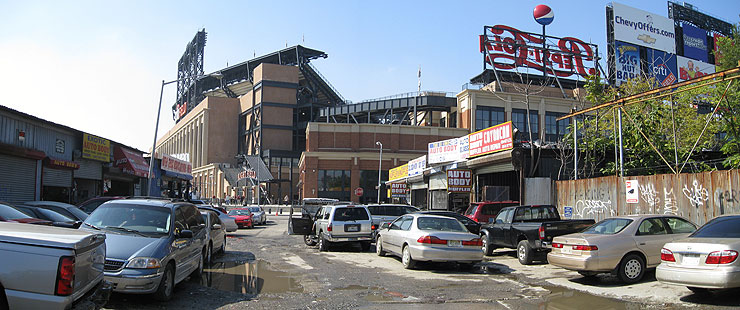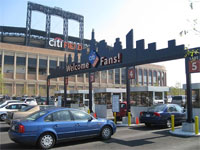
|
For 45 seasons, the New York Mets played in a spacious, utilitarian, and mostly boring stadium named after the man largely responsible for making the Mets a reality.
Likewise, the replacement for Shea Stadium is architecturally and functionally a product of its time, which is an era that produces instant classics by duplicating features found in the classics. As such, Citi Field shares little in common with Shea Stadium, instead drawing inspiration from the best of the new breed of retro parks and a pair of truly retro parks that no longer exist. What it all adds up to is an extremely fan-friendly, amenity overloaded ballpark that's full of quirks, that though contrived are nonetheless delightful, with an extraordinary exterior that brings Brooklyn’s beloved Ebbets Field back to life. Of course, no ballpark would be considered modern without a plethora of exclusive VIP areas or a name derived from a corporate sponsor and the Mets’ home has no shortage of the former and the latter covered thanks to Citigroup, the New York City-based financial services behemoth whose name and logo graces the top of the rotunda that is a replica of the one that fronted Ebbets Field, which like Shea Stadium was used for 45 years until baseball abandoned it. Mets owner Fred Wilpon, a Brooklyn native, made sure that his team’s ballpark looked like the one he grew up going to, which explains why the exterior of Citi Field is strikingly similar in design to that of Ebbets Field. That includes having an America flag centered above the ballpark’s name just like it was in Brooklyn. Additionally, the brick that was used to build Citi Field’s façade has the same color and texture that Ebbets Field was noted for. Although brick, in shades of beige and reddish-brown, is the most notable unit of masonry material used to construct Citi’s picturesque exterior, limestone, granite and cast stone can also be seen. However it’s primarily brick that was used to build the ballpark’s distinctive archways, of which there are 22, each standing 70-feet tall and containing glass paneling. Citi Field has eight more archways than Ebbets Field did and the Mets’ ballpark also has an expanded version of the cable-supported awning that the Brooklyn Dodgers’ home had. In the plaza in front of the awning is the Citi Field Fanwalk, an area inlaid with numerous bricks engraved with personalized inscriptions. There are two sizes of Fanwalk bricks. Fans that paid $195 had room for a three line message on a 4"x 8" brick. Six lines on an 8" x 8" brick cost $340, while the same sized brick with a Mets logo was $395, although the logo reduced the lines available for a message to four. Across from the Fanwalk is the Mets Plaza, where walking paths meander through trees and shrubs that are nicely maintained. All fans that arrive via public transportation descend down a platform adjacent to the landscaped plaza, which is a refreshing respite from its asphalt and concrete-covered environs. As intended, the exterior of Citi Field truly is a sight to behold. There’s not another ballpark in the majors that will force so many mouths agape upon first view (and second and third view, for that matter). It is as stunning in its beauty as it is lacking in originality, which has led to the one criticism levied against the ballpark that will always stick: the home of the Mets is an homage to the Dodgers. Nowhere is that more obvious than the ballpark’s focal point, the rotunda, which was named for one of the sport’s and humanity’s all-time greats, Jackie Robinson, who broke baseball’s color line to don Dodger blue for ten seasons. The Jackie Robinson Rotunda is one of the few features found within a ballpark that is worthy of being called exquisite and its elegance perfectly compliments the jaw dropping appeal of Citi Field’s exterior. Exuding the same wow factor that precedes its entrance, the rotunda is a 19,000-square-foot tribute to the life and times of Jackie Robinson. The words, values and imagery on display throughout the rotunda fondly recall the impact that the groundbreaking Dodger had on not just baseball, but mankind. The rotunda's 160-foot diameter floor is flanked by slightly curving staircases and bisected by a pair of joined escalators that take fans up to field level, where the first thing they see is the Ebbets Club and its mirrored glass that shows Brooklyn’s long gone ballpark in its heyday. Fans wanting to see Mets-related mementos can find them if they take a stroll along the wide promenade that fronts Citi Field, which has three other entrances that are simple in design and name, as each is referred to by its location. The Left Field gate is easily the most Metsy, as above its entrance are seven large wind screens upon which the legends of Queens’ baseball team are seen. The Right Field gate has no such appropriations and is largely void of any sense of place, besides its name. The Left and Right Field entrances bookend the lengthy promenade and between the two gates banners of Mets greats hang from the brick pillars that are evenly spaced along the outer portions of the Citi Field façade. The Bullpen Gate is appropriately set behind the bullpens, which are side by side in right-center field. The Mets’ executive offices are located adjacent to the Bullpen Gate and fans that choose that entrance will find themselves in the Bullpen Plaza, which is most notable as the final resting place of the famous fiberglass Home Run Apple that worked its magic out of an upside-down top hat at Shea Stadium from 1980 through 2008.
Now whenever a Mets player homers a 16-foot tall, 4,800-pound apple emerges from the center field hitter’s background at Citi Field, where an alcove was created to house the modern apple, which rises 15 feet in about three seconds but no longer has a top hat for a base. The Home Run Apple is one of two distinctive elements Citi Field borrowed from Shea Stadium. Orange foul poles are the other. You would think that the Mets would’ve moved the two 100-foot tall foul poles from their old home into their new one, but that wasn’t the case. The originals were disassembled and auctioned off, and those that now stand at Citi Field are as new as the ballpark itself. While Citi Field is the only ballpark in the major leagues to sport non-yellow foul poles, it is one of many to be born with asymmetrical outfield dimensions. In New York’s case, most zigging and zagging occurs from center to right field and the outfield walls collectively change height seven times. What makes them unique is the continuous orange line that traces the uppermost boundary of the irregular fencing. That orange-colored home run line runs, naturally, from orange foul pole to orange foul pole. While any discourse of Citi Field begins with its Ebbets inspired façade on the outside, the hallmarks of the ballpark’s interior are found in the outfield, which is choke-full of great fan areas and clever architectural touches.
While the outfield bridge is purely decorative, the 2K Sports FanFest area near it in center field is quite interactive. Highlighted by Mr. Met's Kiddie Field, a scaled down and turfed version of Citi’s field, baseball and video games galore are found in the FanFast, the most innovative of which is a dunk tank, where fans of all ages can take aim at an employee wearing the jersey of the visiting team. Other diversions within the family-friendly FanFest zone are a pair of batting cages, video game kiosks aplenty and a platform where Mr. Met meets and greets his adoring public, which the Mets’ official mascot does twice before and once during the game. The most creative of cuisine options at the ballpark are conveniently located a short distance from the FanFest in the Taste of the City food court, where an outpost of the city’s popular Shake Shack franchise is stationed alongside Blue Smoke BBQ. Above the connected roofs of the two restaurants is the original New York City silhouette skyline that was atop the gigantic scoreboard at Shea Stadium. Numerous other options to temp the tummy can be found in the outfield, ranging from catch of the day seafood dishes to taquerias to box frites, which are some sort of Belgian-style fries that can be dipped in a variety of sauces, plus the deli sandwiches and sushi found in right field’s World's Fare Market. The specialty concession stands are indeed quite special in no small part because they are primarily overseen by a pair of successful New York restaurateurs. Dave Pasternack is in charge of the “Catch of the Day” fish shack, while Danny Meyer is pretty much in control of everything else mentioned above. Just as they are throughout the park, Nathan's hot dogs are sold at the Aramark-run stands interspersed within the outfield. The original Nathan's beef frankfurter has but 260 calories, less than half the amount (527 calories) found in a serving of the famous New York chain's crinkle cut fries. This you’ll know because caloric statistics often accompany the food listings upon the marquees of Citi Field's rank and file concession stands. On the other end of the food options spectrum is the Acela Club, a 350-seat reservations required restaurant that is the exclusive domain of premium seat holders. The multi-tiered and glass enclosed Acela Club is located in the left field corner on the Excelsior level, which is the name of the ritzy club level between the lower and upper decks, which are respectively known as the Field and Promenade levels. All seats within Citi Field have cup holders and are dark green, so colored because “dark green is the color of a classic ballpark,” Dave Howard, the team’s executive VP for business operations, told the New York Times a month before the Mets’ new classic opened. Roughly 41% (17,300) of those dark green seats are found at field level. That’s more than double the percentage (19.6) that Shea Stadium had on its lowest level. The Excelsior level contains 8,100 seats, the Promenade the uppermost 16,400.
Inspired by Tiger Stadium, which was completely demolished about six months after Citi Field hosted its first game, New York’s version of a home run porch juts out eight feet into fair territory, which is two feet less than Detroit’s did. Behind the five sections of seating (301-305) that make up the Pepsi Porch are flag poles from which Mets championship banners flap and then a large open-air plaza. Looming large behind the porch and its plaza is a 37’ high by 89’ wide sign that says “Pepsi-Cola” in red lettering. The partially scripted sign was modeled after the soft drink company’s iconic sign on the Long Island City waterfront. Colorful advertising signage also frames the two enormous high-definition scoreboards that not only keep fans informed of all the action, but serve to fully enclose the playing field in the one area where the upper level grandstand doesn’t extend to. The bigger structure of the two in center field has a 50’ x 70’ video panel while the companion scoreboard in right-center has a 40’ x 90’ display. In a departure from the norm, ads are as prominent on the backside of both scoreboards as they are on the front side, with many of the ad panels on the back matching those found on the front. An additional video board, sans the surrounding ads, fills in the gap between the Pepsi Porch and club level seats in the right field corner, where it primarily display photos of the current hitter. A pair of double-sided billboards sits atop the large out of town scoreboard that is affixed to the roof of the upper deck in left field, where the top rows of seats have obstructions from the scoreboard’s overhang. To compensate for the partially blocked view, flat screen TVs are mounted to the back of the scoreboard, which also has a panel that rotates through each of baseball’s six division standings. The seats behind the out of town scoreboard aren’t the only ones with poor sightlines, as many seats down the outfield lines in the upper level have no view of the outfield corner that they are closest to. On the lower level, all seats have outstanding views but the concourse is obstructed from dugout to dugout by the Ebbets Club, which is split into two sections of 300 seats that are served by the 6,400 square foot lounge that is responsible from preventing regular folk from even peering into the exclusive areas behind home plate, which include the ten ultra-posh Sterling Suites and the 20 rows of padded Delta Club seats in front of them. The high end seats behind the plate are fenced off from the rest of the field level sections, where ushers are human barriers to those lacking tickets, but the separation that exists in the upper deck is much more pleasing to most fans’ sensibilities.
Citi Field, like all but one of the dozen ballparks that opened in the 2000s, was designed by HOK Sport (which changed its name to Populous before their work was completed) and the renowned firm’s novel approach to upper deck openness in New York leaves about a 10-foot gap between the lower quarter of the upper deck and its remains. East-west running staircases that connect the 40’ wide concourse to the upper aisles leave plenty of room for fans to stand in the spaces in between. While the standing room vantage points at Citi Field aren’t quite as good as other ballparks with split-level upper decks, such a design is a welcome addition in the Mets’ home. Upper deck patrons are treated to their own food court in the circular area atop the rotunda, although the focus there is more on the tried and true ballpark fare than what can be found in the lower deck's innovative Taste of the City. To their credit, the Mets did make this an area to congregate, as high-top and picnic tables are positioned around an oversized version of the team’s interlocking NY logo in a manner that allows fans to watch the game on a video panel attached to the top of the inner brick retaining wall. The behind the plate upper level food court is the only spacious area within Citi Field to be closed off from the playing field, as it was built behind the grandstand, and specifically behind the Promenade Club, the most basic of the ballpark’s exclusive six clubs/restaurants, which have a collective capacity of 3,535. The Promenade Club is responsible for 350 of that total, although it is designed more as a pick up your food and go back to your seat kind of place for those that spend the most to sit in the Promenade (upper) level. Both the Excelsior and Field levels have 1,200-seat restaurants. The club level’s is the Caesars Club and on the lower level stands the Delta Sky360 Club, which is available to all Delta Club seat holders, Besides the aforementioned Acela (350) and Ebbets (400) clubs, there’s also the Delta Sky360 Lounge, a 35-person enclave for those sitting in the first 8 rows of the Delta Club, which just happen to be the most expensive seats fans can buy on a single game basis. Delta Air Lines signed a multiyear deal on September 15, 2008, to sponsor the most exclusive section in Citi Field, hence the name Delta Club, which can hold 1,600 fans in sections that extend from dugout to dugout and begin behind the field level backstop, which is made of real brick on both sides, not just the field-facing side of the wall. The closest a fan can get to fair territory of the Kentucky Bluegrass covered playing field is the “Knothole Alley” that’s on field level between the bullpens and right field foul pole. Officially known as Modell's Clubhouse, it’s behind an angled portion of the warning track and has space for 80 people, mostly on benches with backs, from which the game can be watched through the right field fence in a fairly inexpensive group party area, as tickets were as low as $24 in 2009. Despite the various off-limit pockets of exclusivity spread among Citi Field’s three levels, there is one unifying break in the action besides the 7th Inning Stretch that all can enjoy equally. That takes place in the middle of the 8th inning when the "Meet the Mets" sing-along inspires fans of all ages to mouth the lyrics to the 1962 classic tune, the words of which are shown on the main scoreboard in center field. The main scoreboard mostly obstructs what could actually be a pleasing backdrop for many sitting in the upper level, as the Flushing Bay can only be seen in the upper half of the first base/right field portion of the Promenade grandstand. The same view from those seats includes a glimpse of the runways at LaGuardia Airport and the planes that use them. Because of the baseball stadium’s notorious proximity to the airport, red flashing aircraft warning lights line the back of the frames of Citi Field’s light towers. While Mets owner Fred Wilpon’s professed love of all things Ebbets is obvious one borough removed from where Citi Field’s primary inspiration stood, reminders of his team’s amazin’ history are emblazoned on the left field wall, where seven banners list the Mets' postseason appearances, two of which culminated in world championships (the Brooklyn Dodgers, by contrast, won only one World Series). Those same banners also adorn a wall just inside of the Bullpen Gate entrance, although an astute fan would notice the wording on the 1999 and 2006 banners are slightly altered. A couple of ad billboards removed from the banners on the left field wall, four ovals list the numbers retired by the Mets, only two of which belonged to a player that actually played for the team, and just one of those was worn by a player who starred for them. That would be the #41 worn by Tom Seaver during his dozen seasons as a Met. Gil Hodges’ #14 was retired the year after he died of a heart attack, at which time he was the Mets’ manger. As a player, he hit the first home run in team history, but Hodges played in only 65 games as a Met. His number was retired because of his success in 648 games as the team’s manager, a stint in which he skippered the 1969 Miracle Mets.
A fifth oval, to the right of the other four, contains a retired name rather than number, as “Shea” was given permanent immortality by the Mets prior to their last home opener at Shea Stadium. In a nod to the team’s history, brought on by mounting fan backlash about the absence of it, the Mets announced after their inaugural season at Citi Field that they were attaching the names of their three numbered retirees to the ballpark’s three VIP entrances, and from 2010 going forward the left field VIP entrance will be preceded by Casey Stengel’s name, the third base VIP entrance will bear Tom Seaver’s name, and the first base VIP gate Gil Hodges’. Granted, the majority of Mets fans who clamored for such change won’t be able to enter Citi Field through those VIP gates, but they will be able to walk or stand on the Shea Bridge, the new name given to the concourse-connecting bridge in the outfield. In the same November 21, 2009 press release that “announced plans to expand the presence of club history at Citi Field,” the Mets let it be known that they were re-forming their Hall of Fame Committee as a precursor to the opening of the Mets Hall of Fame & Museum, which debuts in the ballpark’s second season adjacent to the Jackie Robinson Rotunda and near the Mets’ two-story team store. Members of the Mets front office and media appointed to the Hall of Fame Committee are charged with the task of finding worthy candidates for the team’s hall, which was established in 1981 and has had 21 members since Tommie Agee’s 2002 induction. By addressing the need to make Citi Field as much about the legacy in Queens as that which existed in Brooklyn, the Mets hope their modernized Ebbets Field resonates as much with their diehard fan base as the Dodgers’ old home did with theirs. Regardless of whether that happens, Citi Field has joined the pantheon of classic ballparks, past and present, that inspired its creation. You can question its originality and fascination with another team’s history, but not the awe the sight of it elicits nor the wow factor its interior engenders. And such an inside-out combination makes Citi Field one-of-a-kind in its own delightful way.
Location and ParkingCiti Field and Shea Stadium are about as different as two ballparks can be, but they share one important trait: location. Pretty much the same parcel of land in the Queens neighborhood of Willets Point that was home to the Mets for 45 years will continue to be their home for at least 40 more, the duration of the lease that the team signed to move a pop fly away from Shea Stadium and into Citi Field, which was built in Shea’s center field parking lot. That means the same assortment of public transit that serviced Shea Stadium - the Q48 bus, the New York Metro subway's 7 train and Long Island Rail Road, and the Grand Central Parkway and I-678 – now serve Citi Field, which like its predecessor is in the flight paths of planes arriving and departing at nearby LaGuardia Airport. Just as it was during Shea’s days, the eastern boundary of ballpark property is 126th Street. And just as it long has been, 126th Street and the side streets running north from it remain notorious for their auto repair shops and scrap yards. The omnipresence of such businesses is the reason that the Willets Point peninsula is known as the "Iron Triangle." In the past, the chop shops and scrap heaps were a good distance away from where the Mets played, but with the team’s relocation in their direction, Citi Field now abuts 126th Street and casts its shadows upon its unsightly neighbors. Fans standing on the plaza of the Pepsi Porch and those sitting in the furthermost reaches of the upper first base grandstand have a great lay of that land, which includes piles of car part rubble stacked on the roofs of the businesses that extend down the pair of junk car lined, pothole filled side streets that just happen to be directly across from the Right Field and Bullpen gates. Perhaps it was because of their distaste for their grungy neighbors that the Mets desired to erect the two jumbo scoreboards nearly side by side in the outfield, thereby blocking views from inside the park of what lay directly beyond it. But to accomplish that mission Flushing Bay had to be blocked from view as well, so Citi Field’s surprisingly close proximity to water on its northwestern side is hard to establish from most regions within the ballpark. Citi Field, like Shea Stadium before it, is in the north end of Flushing Meadows–Corona Park, site of two World’s Fairs (1939 and 1964) and still home to the iconic Unisphere, the 140’ tall stainless steel globe that was the thematic symbol of the ‘64 Fair. Since 1978, Flushing Meadows Park has been home to the USTA National Tennis Center, the host venue for the annual US Open, and the center’s two large stadiums are so close to Citi Field that the ballpark’s parking lots are used during the two-week tournament. Citi Field has plenty of parking, most of it available on the former site of Shea Stadium, proof of which exists via the brass markers placed among the sea of asphalt lined spaces that designate where home plate, the bases and pitcher’s mound once were. These mementos are all found between lots B and D, where they are embedded in driving lanes, a placement that ensures fans can always see the markers since cars can’t park on them. Between on-site and adjacent off-site parking, the Mets control 8,500 spaces. Another few thousand are available in the surrounding area. While parking is plentiful it isn’t cheap. Attendants manning the toll booth style structures that fans must pass through en route to the expansive primary parking lot collect the equivalent of oodles of tokens. In Citi Field’s inaugural year that amounted to $18 per car. The Jackie Robinson Rotunda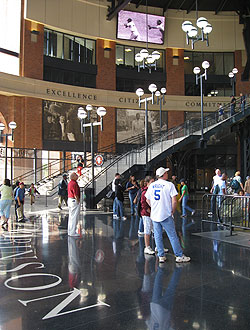 In 2002, Jackie Robinson’s daughter, Sharon, authored a book extolling the values she believed that her father lived his life by. Courage, determination, teamwork, persistence, integrity, citizenship, justice, commitment and excellence are listed on the dust jacket of the book, called “Jackie's Nine: Jackie Robinson's Values to Live By.”
In 2002, Jackie Robinson’s daughter, Sharon, authored a book extolling the values she believed that her father lived his life by. Courage, determination, teamwork, persistence, integrity, citizenship, justice, commitment and excellence are listed on the dust jacket of the book, called “Jackie's Nine: Jackie Robinson's Values to Live By.”
Those meaningful words are now more visible to a much larger audience thanks to the rotunda bearing Robinson’s name, where his nine attributed values are prominently displayed on the curved walls and etched into the faux-marble Terrazzo flooring. Those values, and so much more, await all fans who enter Citi Field’s main entrance, where the Jackie Robinson Rotunda was modeled after Brooklyn’s iconic ballpark and dedicated to the American icon on April 15, 2009. The impact that Robinson had on baseball and society was profound and so too is the photo-friendly rotunda, with its brick-built exterior and an elegantly appropriated 19,000-square-feet interior that is lighted by chandeliers befitting of such a grand entrance. Directly above the brick archways through which fans enter the rotunda are some of the most famous, and appropriate, words that Robinson ever spoke: "A life is not important except in the impact it has on other lives." Upon the more visible interior walling are large tiled black and white pictures of Robinson, including one of him walking outside of Ebbets Field that enables fans to compare the ballpark they just entered to the Brooklyn shrine that was torn down 49 years before Citi Field opened. Affixed above the brick portion of the interior wall are video screens – one each on the rotunda’s east and west side - that show a loop of highlights from Robinson’s career. The ground-level tribute to “Jackie’s Nine” is accompanied by captions that relate to each of his values. For example, beneath the word COURAGE are the words, "In 1947, Jackie broke baseball's color barrier, becoming the first African-American player in Major League Baseball's modern era, opening doors for generations of Americans." A frequent stop for fans along the rotunda’s 160-foot diameter floor is the eight-foot sculpture of Robinson’s number 42. Although it’s slathered in Dodger blue, Mets fans line up to have a picture taken with the number that was retired throughout Major League Baseball in 1997. A dozen years later, on the sport’s official Jackie Robinson Day, the Jackie Robinson Rotunda was officially dedicated in ceremonies that preceded the Mets’ second ever game, and ultimately first victory, at Citi Field.
Ballpark HistoryIf former Mayor Rudy Giuliani had his way, the Mets and his beloved Yankees would have been playing in $1.6 billion worth of retractable-roofed ballparks well before 2009. As one of Giuliani’s last acts in public office, on December, 28, 2001, he announced non-binding agreements had been struck with both of New York’s baseball teams whereby the public would foot half the bill to build each team an $800 million ballpark where they eventually were built. But the tentative deals Giuliani had reached with the Mets and Yankees during his last week in office were eschewed by his successor, Michael Bloomberg, during his first week in City Hall due to budgetary reasons. Still, the Mets had reason to be optimistic even after Bloomberg put Giuliani’s plan on the backburner on January 7, 2002, when the new mayor said new stadiums were not an immediate priority of his administration. That’s because organizers for New York City’s bid to host the 2012 Summer Olympics eventually turned their attention to Queens as a site for the main Olympic stadium, after plans for such a stadium fell through on Manhattan’s West Side. Under terms of a hastily put together deal in June of 2005, the Mets would pay for the cost of the stadium while the city and state would contribute $180 million for infrastructure improvements. Set to open in 2009 regardless of the city’s Olympic bid outcome, the public would pay the $100 million cost to convert the stadium into an 80,000-seat opening and closing ceremonies showpiece if the city were awarded the 2012 Games. If that was the case, it was decided that the Mets would play their home games in the Yankees' stadium for a season while athletes from all over the world used theirs during the summer of 2012. And even if the NYC bid lost out, the Mets would still have the 100% public subsidy for the improvements to the infrastructure around the stadium that they wanted. City Hall had no qualms with that, as the mayor’s office concluded that the cost to maintain Shea Stadium for another 30 years would be $212 million. The new ballpark that was to be privately financed by the Mets would be maintained by them as well. By contrast, the city was responsible for the maintenance of Shea Stadium.
Eight and a half months after the International Olympic Committee made their decision, the Mets unveiled their vision for their new ballpark, which was a modification of an Ebbets Field-inspired model that team owner Fred Wilpon first presented in 1998, when his team began their initial pursuit of a Shea Stadium replacement. Ceremonial groundbreaking for that replacement took place on November 13, 2006, with Mets players Jose Reyes and David Wright hoisting dirt alongside the mayor and other dignitaries. Before their shovels unearthed dirt it was announced the future ballpark would be named Citi Field and its grand entrance the Jackie Robinson Rotunda. The naming rights agreement that Citigroup signed was the largest ever of its kind, a $20 million per year pact for 20 years, totaling a staggering sum of $400 million. Eventually that total would be a cause of controversy, as Citigroup became one of the more visible recipients of federal financial aid during the economic crisis of 2008, a year in which they received $45 billion in bailout money from the government’s Troubled Asset Relief Program (TARP). That prompted Republican New York City Council members Vincent Ignizio and James Oddo to suggest that the ballpark’s name be altered to "Citi/Taxpayer Field” in light of the public’s bankrolling of TARP. Not gonna happen was the Mets’ response. For their part, Citi said no TARP funds would be used in their sponsorship deal with the team. Treasury Secretary Tim Geithner was brought into the naming rights fray shortly after he was sworn into his position when two Congressmen asked him to cancel Citi’s deal on grounds that it was a troubling use of funds by a troubled company. Geithner rejected the demands of House members Dennis Kucinich, D-Ohio, and Ted Poe, R-Texas, a decision finally giving the name Citi Field the permanence it had lacked during the financial service company’s tumultuous 2008. And so it came to pass that when the ballpark officially opened on March 29, 2009, for a college baseball game, the Citi Field logo was securely in place atop the Jackie Robinson Rotunda when the first of 22,397 fans walked through its gates at 10:40 a.m. Later that afternoon, John Franco threw out the ceremonial first pitch and Georgetown beat his alma matter, St. John’s, 6-4 in what was actually a home game for the Hoyas since the original match-up was to have taken place on their campus. As such, Georgetown's Sean Lamont hit the first ball out of the park in the home half of the third, his estimated 340-foot home run just clearing the wall in left field. Neither it nor the rest of the outfield fence had distances painted on it yet. Those in attendance on the misty Sunday afternoon that Citi Field made its debut were collectively a part of the seventh largest crowd to ever watch an NCAA baseball game. And by paying $5 a ticket, they were also the first paying customers to view the ballpark that was jointly built by Hunt Construction Group and Bovis Lend Lease under the guidance of Queens Ballpark Company, LLC, a company created by the family of the Mets' owner to develop and then operate the stadium, which had an estimated cost of $800 million and hosted two Red Sox-Mets exhibitions before the first National League game was played in it on April 13, 2009. On that date, the San Diego Padres' Jody Gerut christened Citi Field with a bang by becoming the first player in baseball's storied history to open a new major league ballpark with a leadoff home run. He did it by taking the Mets' Mike Pelfrey deep on the third pitch of the game, which was won by the Padres 6-5. Gerut's homer set the tone for the Mets' 2009 season, as they stumbled to a 70-92 record and had to sweep three games from the Houston Astros on the final weekend of the season to finish with a winning record (41-40) at home. But before their disastrous season could come to a conclusion, the New York Post reported on September 6, 2009, that the Mets' had more than just on-field problems, as the structure surrounding their playing field was suffering from "mold, falling signs and concrete, flooding in outfield seats, faulty electrical wiring and shoddy tile work." The Post specifically cited water damage that plagued Jerry Seinfeld's suite in their exclusive exposé, in which author James Fanelli wrote that a Mets executive "acknowledged some of the problems, but called them minor and not unexpected." One problem that was unforeseen by the Mets and their ballpark design team involved a visibility issue for pitchers in the visiting team's bullpen, which was stacked in right-center field behind the Mets' bullpen in a manner that obstructed views of the playing field for the out-of-towners. To alleviate the problem, work crews rebuilt the bullpens during Citi Field's first offseason so that they are now side-by-side, inside of one being on top of the other. While the ballpark, starting with the repositioned bullpens, will be a continual work in progress on a small scale for years to come, the neighborhood in the shadows of Citi Field is poised for a $3 billion redevelopment, much to the Mets' pleasure. Long known as the Iron Triangle for its array of chop shops, scrap yards and waste plants (and also as a place lacking trash removal service and a sanitary sewer system), Willets Point is the target of an ambitious urban renewal plan that Mayor Bloomberg announced on May 1, 2007 and the City Council, by a 42 to 2 vote, approved on November 13, 2008. At the crux of the plan for the 62-acre neighborhood is the removal of its industrial component to accommodate a slew of mix-use developments, including housing, retail and office space. This, of course, angered many of the 250 or so businesses and 70 landowners within Willets Point, the most prominent of whom organized into an entity called the Willets Point Industry and Realty Association (WPIRA) to oppose the plan, which would allow the city to take their land through eminent domain. The WPIRA challenged the legality of the redevelopment plan in Federal District Court, where Judge Edward R. Korman ruled on November 25, 2008, that while the plaintiffs “are understandably aggrieved by the fact that the plan that the city is in the process of implementing has no place for them,” their claim nonetheless lacked the legal merit necessary to block it. By the time Korman released his 22-page ruling, New York City had already purchased over half the land in Willets Point, where the holdouts showed their disdain during Citi Field's inaugural season by placing banners bemoaning their plight, one of which exclaimed "Welcome to Seizure City." Call it what you will, but the neighborhood long neglected by the city will soon be spruced up to compliment the Mets' Citi. That will take some time, but a decade after the ballpark opened the infamous Iron Triangle will be but a memory, just like Shea Stadium already is.
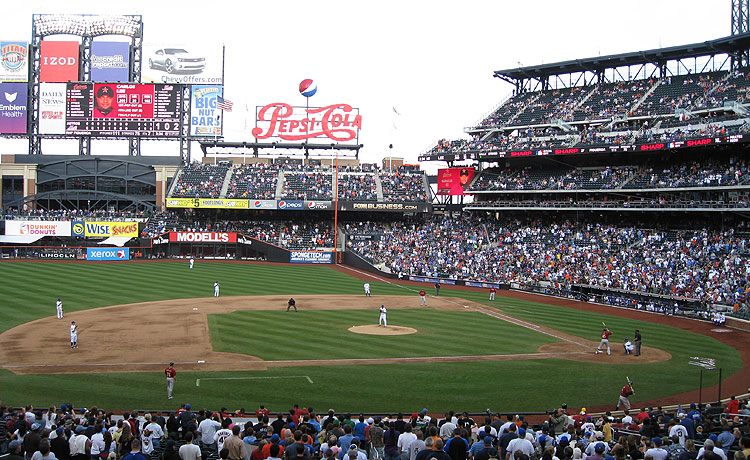
Citi Field Facts, Figures & Footnotes
| ||||||||||||||||||||||||||||||||||||||||||||
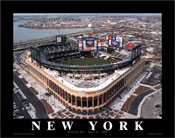
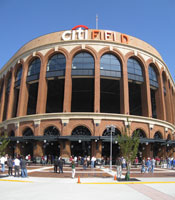
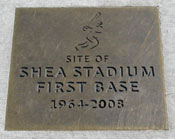
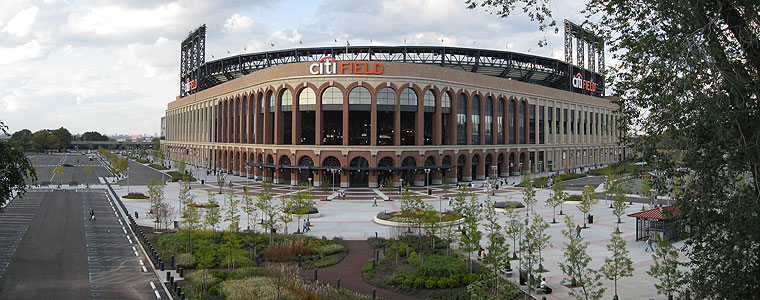
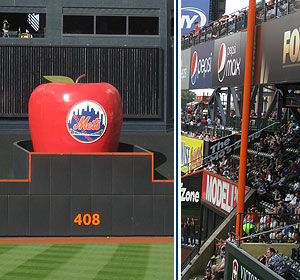 Just as Shea was replaced, so too was its nine-foot tall apple. But while Citi Field is 13,801 seats smaller than its predecessor, its apple is bigger and much heavier than the 582-pound original.
Just as Shea was replaced, so too was its nine-foot tall apple. But while Citi Field is 13,801 seats smaller than its predecessor, its apple is bigger and much heavier than the 582-pound original.
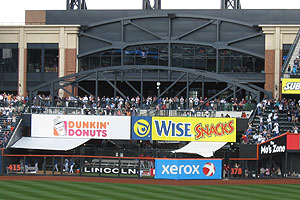 Chief among them is the bridge motif that is rampant throughout the ballpark, where bridge-like trusses are exposed in the concourses, but most evident in right-center, where a replica bridge was built for all to see and traverse. Technically added to reinforce “the Mets' connection to New York's five boroughs,” the bridge actually connects the center and right field concourses. Its curved steel beams echo the shape seen in the more pronounced archways outside the ballpark and in the similarly sloped light banks that rise above it.
Chief among them is the bridge motif that is rampant throughout the ballpark, where bridge-like trusses are exposed in the concourses, but most evident in right-center, where a replica bridge was built for all to see and traverse. Technically added to reinforce “the Mets' connection to New York's five boroughs,” the bridge actually connects the center and right field concourses. Its curved steel beams echo the shape seen in the more pronounced archways outside the ballpark and in the similarly sloped light banks that rise above it.
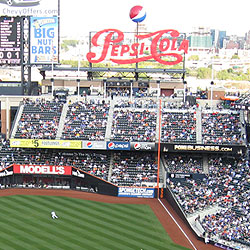 Those three levels combine to hold Citi Field’s listed capacity of 41,800. The most publicized of those seats are the 1,284 that comprise the second story section in right field named the Pepsi Porch.
Those three levels combine to hold Citi Field’s listed capacity of 41,800. The most publicized of those seats are the 1,284 that comprise the second story section in right field named the Pepsi Porch.
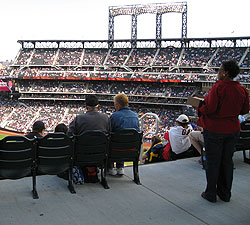 Unlike the lower level, which is decidedly restrictive between the foul poles, the upper level has a concourse that is completely open to the playing field. This is accomplished through the split-level design that the ballpark’s architect first unveiled in
Unlike the lower level, which is decidedly restrictive between the foul poles, the upper level has a concourse that is completely open to the playing field. This is accomplished through the split-level design that the ballpark’s architect first unveiled in 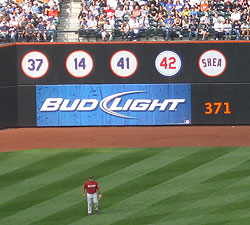 As for the other two numbers, the Mets’ first manager, Casey Stengel, had his #37 retired by the team in 1965, three days after he announced his retirement. Jackie Robinson’s #42 was retired throughout baseball in 1997, although the Mets’ likely would’ve done it anyway given the prominence of his legacy at Citi Field.
As for the other two numbers, the Mets’ first manager, Casey Stengel, had his #37 retired by the team in 1965, three days after he announced his retirement. Jackie Robinson’s #42 was retired throughout baseball in 1997, although the Mets’ likely would’ve done it anyway given the prominence of his legacy at Citi Field.
